Editoral
Controlling the third wave: Learning from Nigeria’s response to COVID-19 outbreaks
Posted: 21-08-2021 01:30:30 PM
On the 27th of February, 2020, the first case of coronavirus disease (COVID-19) outbreak was recorded in Nigeria. Since then, a multi-partner incident management system hosted at the Nigeria Centre for Disease Control (NCDC) has been leading national response. We are working closely with all the 36 states and Federal Capital Territory to ensure national health security. Given the novelty and epi-dynamics of the virus, the national response plan has been continuously revised through different stages of the outbreak. The level of control during the first and second waves of the outbreak can be attributed to the instituted public health measures.
With the ongoing third wave, it is critical to assess the national readiness for outbreak control. In line with this, the national team from the Nigeria Centre for Disease Control in collaboration with the World Health Organisation recently conducted an Intra Action Review (IARs) with key stakeholders across the six regions in Nigeria. The sub-national stakeholders included Incident Managers, State Epidemiologists, and leads of Risk Communication, Surveillance, Laboratory and Research pillars from each of the 36 States and the FCT. The objectives of the regional IARs were to:
Provide an opportunity for national and subnational stakeholders to share experience and collectively analyse ongoing in-country COVID-19 response;
Facilitate consensus building and lesson learning amongst the response stakeholders to improve the current response by preventing recurrent errors and reproducing success;
Document and apply lessons learning for health systems strengthening.
Specifically, the regional IAR provided a unique opportunity to provide updates on overall response activities, what went well, what went less well and why, and what can be done to improve current response. The states were also able to update their incident action plans through IAR to inform public health measures for the control of the ongoing third wave.
Subsequently, the national COVID-19 response team convened a national IAR meeting to discuss findings from the states and update the national COVID-19 plan. Through interactive sessions, the IAR provided an opportunity to review outbreak response around key ten technical – Coordination, Surveillance, Laboratory, Risk communication, Point of Entry, Logistics, Vaccine, Case management, Infection prevention and control, and Research pillars.
An important outcome of the meeting was the joint revision of COVID-19 response plan, with clear roles for every stakeholder involved in outbreak preparedness and response. The critical next step is to finalise the workplan and work with states and WHO to mobilise resources for the implementation of the revised plan for the control of the third wave.
The NCDC remains committed to working with state epidemiologists, state Ministries of Health, partners and other relevant stakeholders towards improving Nigeria’s preparedness and response to infectious disease outbreaks. More importantly, states are enjoined to improve ownership and ensure implementation of the revised workplan.
Summary of Incidents
Notes
1. Information for this disease was retrieved from the Technical Working Group and Situation Reports
2. Case Fatality Rate (CFR) for this disease is reported for confirmed cases only
3. Information for this disease was retrieved from IDSR 002 data
4. CFR for this disease is reported for total cases i.e. suspected + confirmed
5. Information for sentinel influenza was retrieved from the laboratory
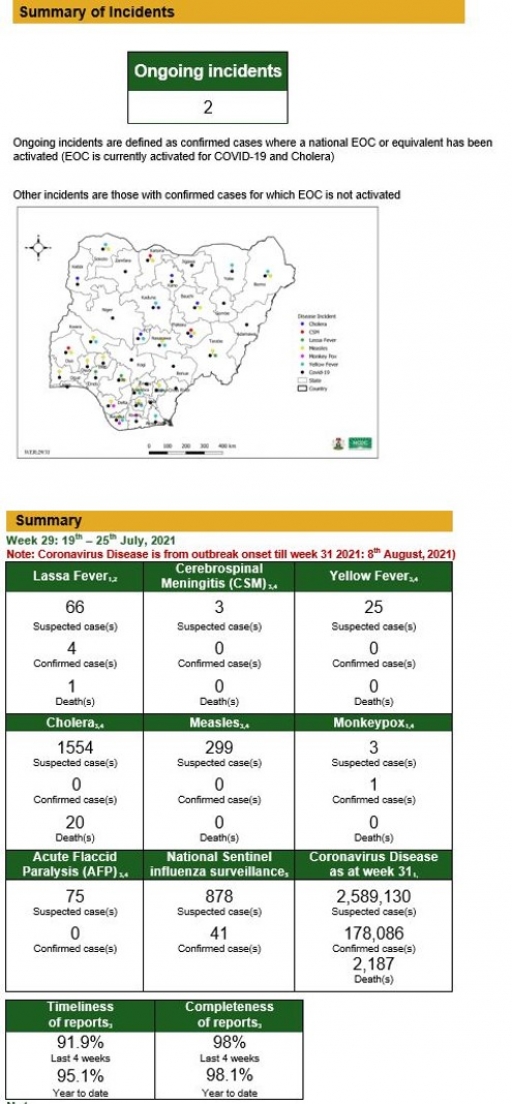
Lassa Fever
Key points
- There were 66 suspected cases, four were laboratory confirmed and one death was recorded from four LGAs in three states
Actions
To date:
- Conducted 2021 Lassa fever (LF) high burden states preparedness/response engagement meeting
- Dissemination of reviewed case management and safe burial practices guidelines
- Ensured all five LF molecular laboratories in the NCDC network are working at full capacity for timely testing of samples with reduced turnaround time
Planned:
- Finalise LF five-year strategic plan
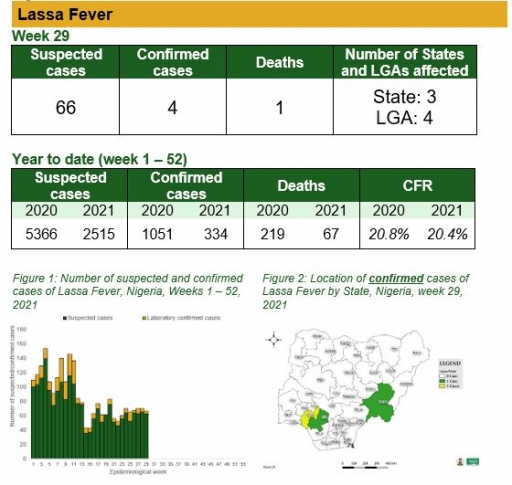
Cerebrospinal Meningitis (CSM)
Key points
- There were three suspected cases of cerebrospinal meningitis (CSM) reported from three LGAs in three states (Katsina – 1, Oyo – 1 & Plateau – 1). None were laboratory confirmed and no death was recorded.
Actions
To date:
- National CSM TWG meets weekly to review reports from states and plan appropriately
- Enhanced surveillance in all states
Planned:
- Continue harmonisation of the national line list and SORMAS data
Continue to ensure that states reporting cases send their line lists and collect CSM samples
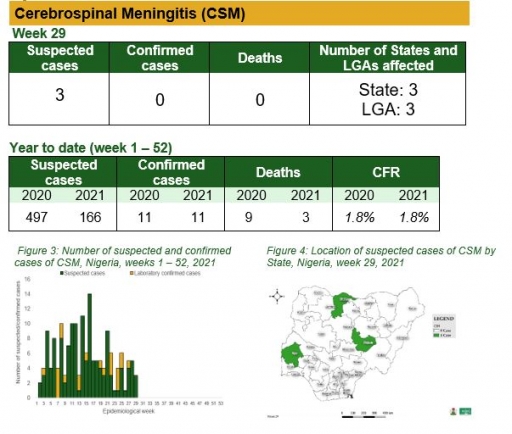
Yellow Fever
Key points
- There were 25 suspected cases of Yellow Fever (YF) reported from 23 LGAs in 11 states and FCT. None were laboratory confirmed and no death was recorded
Actions
To date:
- National YF multi-partner Technical Working Group (TWG) continues to coordinate activities across states.
- Ongoing plans to strengthen orientation of at-risk states on YF surveillance
- Ensured availability of reagents and consumables in all testing laboratories
Planned:
- Continue monitoring and analysis of YF (Yellow fever) data across all states and FCT to guide response
- Continue coordination of prompt transportation samples to the laboratories
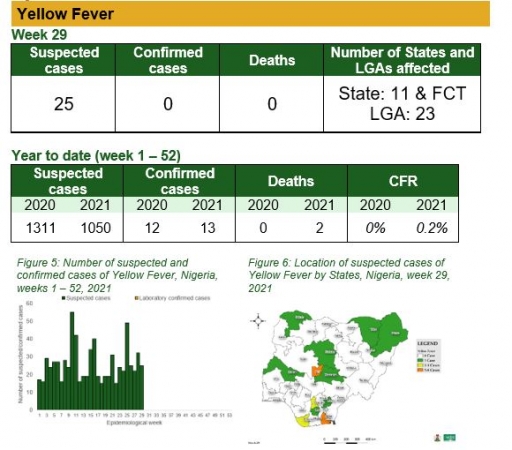
Cholera
Key points
- There were 1554 suspected cases of cholera reported from 88 LGAs in five states and FCT (Bauchi – 924, FCT – 76, Kaduna – 117, Kano – 49, Kebbi – 253 & Plateau – 135). None were laboratory confirmed and 20 deaths were recorded
Actions
To date
- National Cholera Multi-Sectoral Technical Working Group (TWG) is monitoring all states and supporting affected states
- National Rapid Response Teams (RRTs) with response commodities were deployed to support the response in all affected states
- Cholera jingles being aired in English and local languages across the country
Planned:
- Continue follow up and monitoring of non-reporting states
- Build capacity for sample collection, transportation, and laboratory diagnosis across states
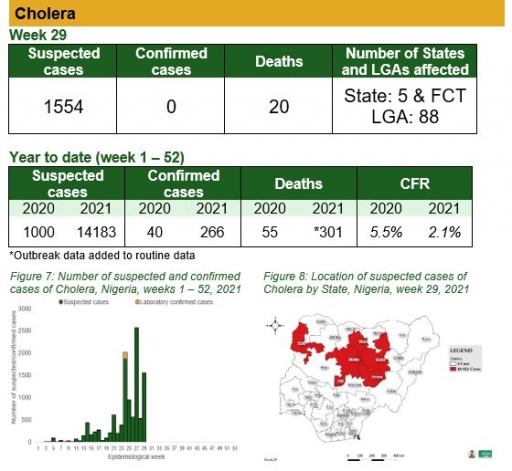
Measles
Key points
- There were 299 suspected cases of Measles reported from 72 LGAs in 18 states. None were laboratory confirmed and no death was recorded
Actions
To date
- National Measles TWG is closely monitoring measles surveillance data and providing feedback to relevant agencies and development partners
- Ongoing weekly surveillance and laboratory data harmonisation
Planned:
- Intensify follow up with states to update and transmit line list
- Continue monthly measles surveillance data review
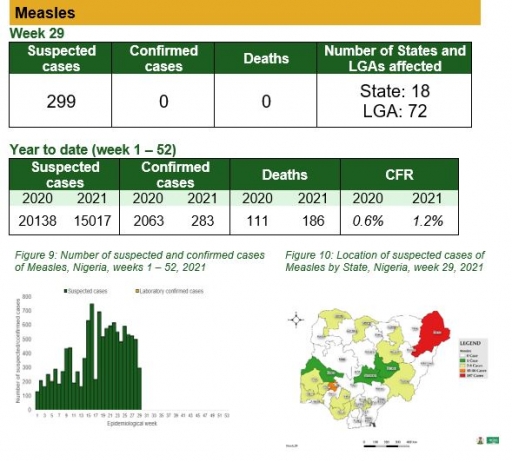
Measles
Key points
- There were three suspected cases of monkeypox reported in four LGAs in three state (Bayelsa – 1, Delta – 1 & Rivers – 1). One case was laboratory confirmed and no death was recorded
Actions
To date
- Enhanced Surveillance ongoing in Rivers, Delta and Bayelsa States
- National Monkeypox Technical Working Group (TWG) is monitoring activities in all states
Planned:
- Enhance surveillance for monkeypox in high burden states
- Continue harmonisation of the national line list and SORMAS data
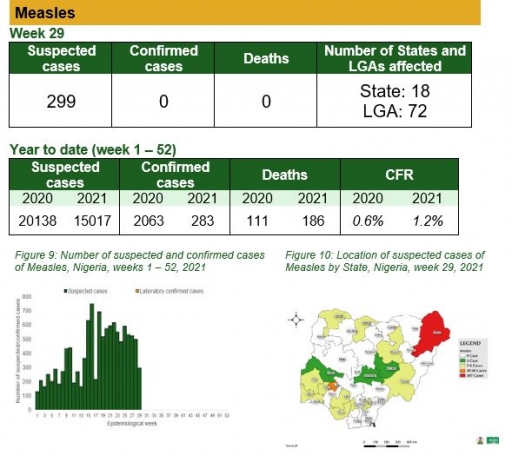
Acute Flaccid Paralysis (AFP)
Key points
There were 75 suspected cases of AFP reported from 67 LGAs in 20 states and FCT. None were laboratory confirmed and no death was recorded.
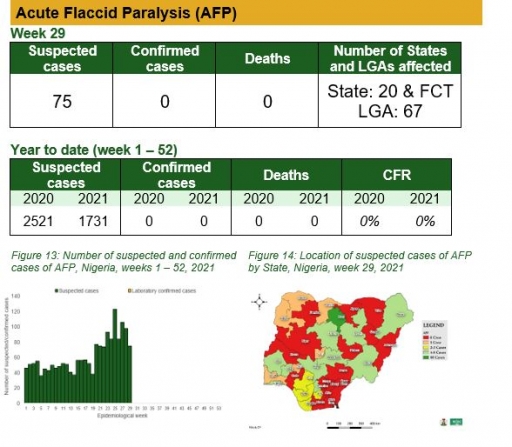
National Influenza Sentinel Surveillance
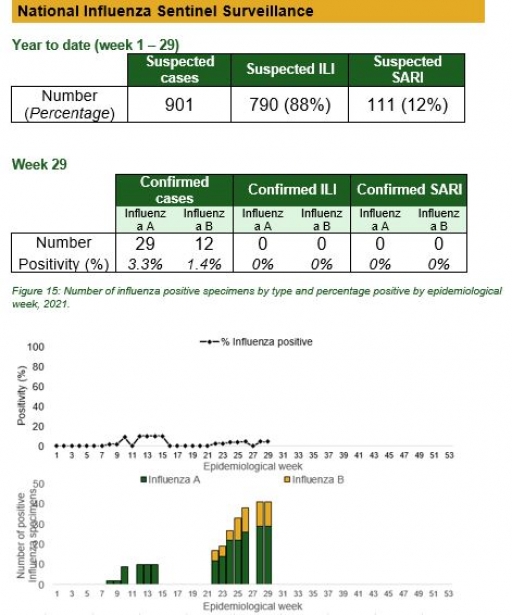
Coronavirus Disease (COVID-19)
Actions
To date:
- National COVID-19 multi-partner Emergency Operations Centre (EOC) continues to coordinate response activities across states
- Ongoing intensivist training in South-South and South-East geopolitical zones
- Concluded the assessment of oxygen capacity at treatment/isolation centres using the assessment checklist
- Disseminated COVID-19 articles on current variants and disease trends to health workers
Planned:
-Deploy antigen-based rapid diagnostic test (Ag-RDT) kits and sample collection materials to the selected states
- Intensify genomic surveillance activities
- Finalise Local Government Area (LGA) / State transmission categorisation
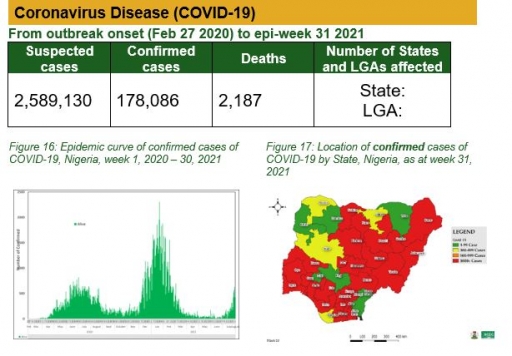
Timeliness and Completeness of Reports

Timeliness and Completeness of Reports by State
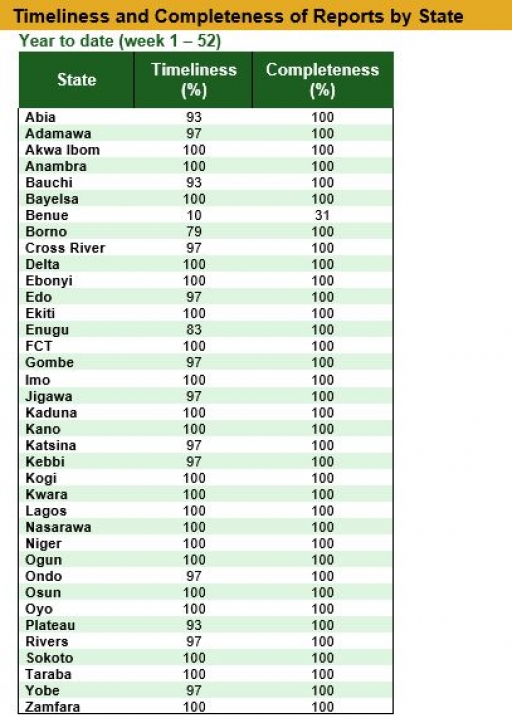














 Toll Free Number: 6232
Toll Free Number: 6232 Whatsapp: +234 708 711 0839
Whatsapp: +234 708 711 0839 SMS Number: +234 809 955 5577
SMS Number: +234 809 955 5577 